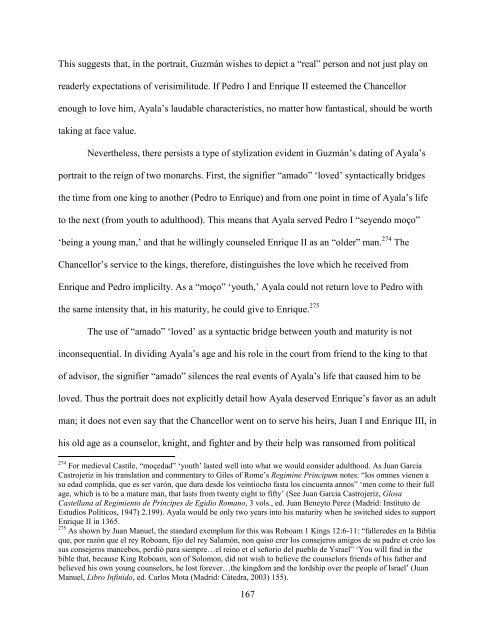WRITING AUTHORITY IN LATE MEDIEVAL ... - Cornell University
WRITING AUTHORITY IN LATE MEDIEVAL ... - Cornell University
WRITING AUTHORITY IN LATE MEDIEVAL ... - Cornell University
You also want an ePaper? Increase the reach of your titles
YUMPU automatically turns print PDFs into web optimized ePapers that Google loves.
This suggests that, in the portrait, Guzmán wishes to depict a “real” person and not just play on<br />
readerly expectations of verisimilitude. If Pedro I and Enrique II esteemed the Chancellor<br />
enough to love him, Ayala’s laudable characteristics, no matter how fantastical, should be worth<br />
taking at face value.<br />
Nevertheless, there persists a type of stylization evident in Guzmán’s dating of Ayala’s<br />
portrait to the reign of two monarchs. First, the signifier “amado” ‘loved’ syntactically bridges<br />
the time from one king to another (Pedro to Enrique) and from one point in time of Ayala’s life<br />
to the next (from youth to adulthood). This means that Ayala served Pedro I “seyendo moço”<br />
‘being a young man,’ and that he willingly counseled Enrique II as an “older” man. 274 The<br />
Chancellor’s service to the kings, therefore, distinguishes the love which he received from<br />
Enrique and Pedro implicilty. As a “moço” ‘youth,’ Ayala could not return love to Pedro with<br />
the same intensity that, in his maturity, he could give to Enrique. 275<br />
The use of “amado” ‘loved’ as a syntactic bridge between youth and maturity is not<br />
inconsequential. In dividing Ayala’s age and his role in the court from friend to the king to that<br />
of advisor, the signifier “amado” silences the real events of Ayala’s life that caused him to be<br />
loved. Thus the portrait does not explicitly detail how Ayala deserved Enrique’s favor as an adult<br />
man; it does not even say that the Chancellor went on to serve his heirs, Juan I and Enrique III, in<br />
his old age as a counselor, knight, and fighter and by their help was ransomed from political<br />
274 For medieval Castile, “moçedad” ‘youth’ lasted well into what we would consider adulthood. As Juan Garcia<br />
Castrojeriz in his translation and commentary to Giles of Rome’s Regimine Principum notes: “los ommes vienen a<br />
su edad complida, que es ser varón, que dura desde los veintiocho fasta los cincuenta annos” ‘men come to their full<br />
age, which is to be a mature man, that lasts from twenty eight to fifty’ (See Juan Garcia Castrojeriz, Glosa<br />
Castellana al Regimiento de Príncipes de Egidio Romano, 3 vols., ed. Juan Beneyto Perez (Madrid: Instituto de<br />
Estudios Politicos, 1947) 2.199). Ayala would be only two years into his maturity when he switched sides to support<br />
Enrique II in 1365.<br />
275 As shown by Juan Manuel, the standard exemplum for this was Roboam 1 Kings 12:6-11: “falleredes en la Biblia<br />
que, por razón que el rey Roboam, fijo del rey Salamón, non quiso crer los consejeros amigos de su padre et créo los<br />
sus consejeros mancebos, perdió para siempre…el reino et el señorio del pueblo de Ysrael” ‘You will find in the<br />
bible that, because King Roboam, son of Solomon, did not wish to believe the counselors friends of his father and<br />
believed his own young counselors, he lost forever…the kingdom and the lordship over the people of Israel’ (Juan<br />
Manuel, Libro Infinido, ed. Carlos Mota (Madrid: Cátedra, 2003) 155).<br />
167
















